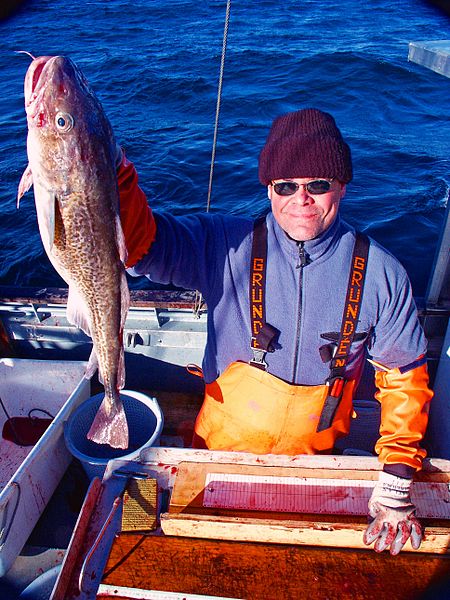Ocean Report
A couple of items on things oceanic came to my attention this week.
NYT had a story on collapse of the cod fishery:
The Shocking News About Cod
The ideal fish for human consumption would mature quickly and reproduce in staggering numbers.
This does not describe the Atlantic cod. Cod mature late — at 4 to 6 years old — and they can live as long as 25 years. Female cod do, in fact, produce astonishing numbers of eggs. But older cod lay two or three times as many eggs as younger cod. This means that a healthy cod population must include relatively large numbers of older fish.
A recent survey of cod catches in Northern Europe shows exactly the opposite. Extrapolating from survey numbers, scientists at a British government fisheries agency estimate that there are nearly 200 million 1-year-old cod in the North Sea but only 18 million 3-year-olds. As for older cod, the numbers are shocking. The survey team estimates that in 2011 there were only 600 12- to 13-year-old cod, a third of which were caught, and not a single fish older than 13 has been caught in the past year.
Read the whole article? Important stuff.
Paul Pickett in Oly shared this new NOAA app that shows sea level rise and coastal impacts. We have been talking in Oly about actions by the Washington State Department of Ecology. DOE has blocked a shoreline plan in Jefferson County that prohibited pen fish farming. This is the industrial practice of raising fish such as Atlantic salmon in pens. We won’t have healthy fisheries if we raise fish to eat in pens. Ecology is also stepping in on the the Olympia shoreline plan in ways that may help the Port of Olympia and thwart environmental action that has wide public support. We are talking in Olympia about how regulatory agencies can be captured by the industries they regulate and what we can do about it.
I think we have to ask the right question and that question is “why would regulatory agencies thwart reasonable environmental actions?” The answer is profit, capitalism; economic interests are in control and dictate to us all. Disaster capitalism. Disaster, capitalism. Disaster. Capitalism.
Here is the sea level rise app. NOAA is not a regulatory agency per ser, more of a pure science agency. It’s harder to capture science agencies than it is to capture regulatory agencies who are able to weigh science against economic interests.
It’s kind of tragic and ironic that we are both depleting the ocean and increasing the ocean’s coverage of the planet at the same time. The Greenland ice cap is melting. Start looking hard at the sea level rise application and plan accordingly. There are going to be some opportunities for profit in the coming troubles.
Sea Level Rise and Coastal Flooding Impacts Viewer
 Features
- Displays potential future sea levels
- Provides simulations of sea level rise at local landmarks
- Communicates the spatial uncertainty of mapped sea levels
- Models potential marsh migration due to sea level rise
- Overlays social and economic data onto potential sea level rise
- Examines how tidal flooding will become more frequent with sea level rise
Overview
View the current status of the tool.
 Being able to visualize potential impacts from sea level rise is a powerful teaching and planning tool, and the Sea Level Rise Viewer brings this capability to coastal communities. A slider bar is used to show how various levels of sea level rise will impact coastal communities. Completed areas include Mississippi, Alabama, Texas, Florida, and Georgia, with additional coastal counties to be added in the near future. Visuals and the accompanying data and information cover sea level rise inundation, uncertainty, flood frequency, marsh impacts, and socioeconomics.
Being able to visualize potential impacts from sea level rise is a powerful teaching and planning tool, and the Sea Level Rise Viewer brings this capability to coastal communities. A slider bar is used to show how various levels of sea level rise will impact coastal communities. Completed areas include Mississippi, Alabama, Texas, Florida, and Georgia, with additional coastal counties to be added in the near future. Visuals and the accompanying data and information cover sea level rise inundation, uncertainty, flood frequency, marsh impacts, and socioeconomics.
Acknowledgements
The NOAA Coastal Services Center would like to acknowledge those organizations that provided direct content used in this tool or feedback, ideas, and reviews over the course of the tool’s development. Specifically the Center would like to acknowledge the following groups.

